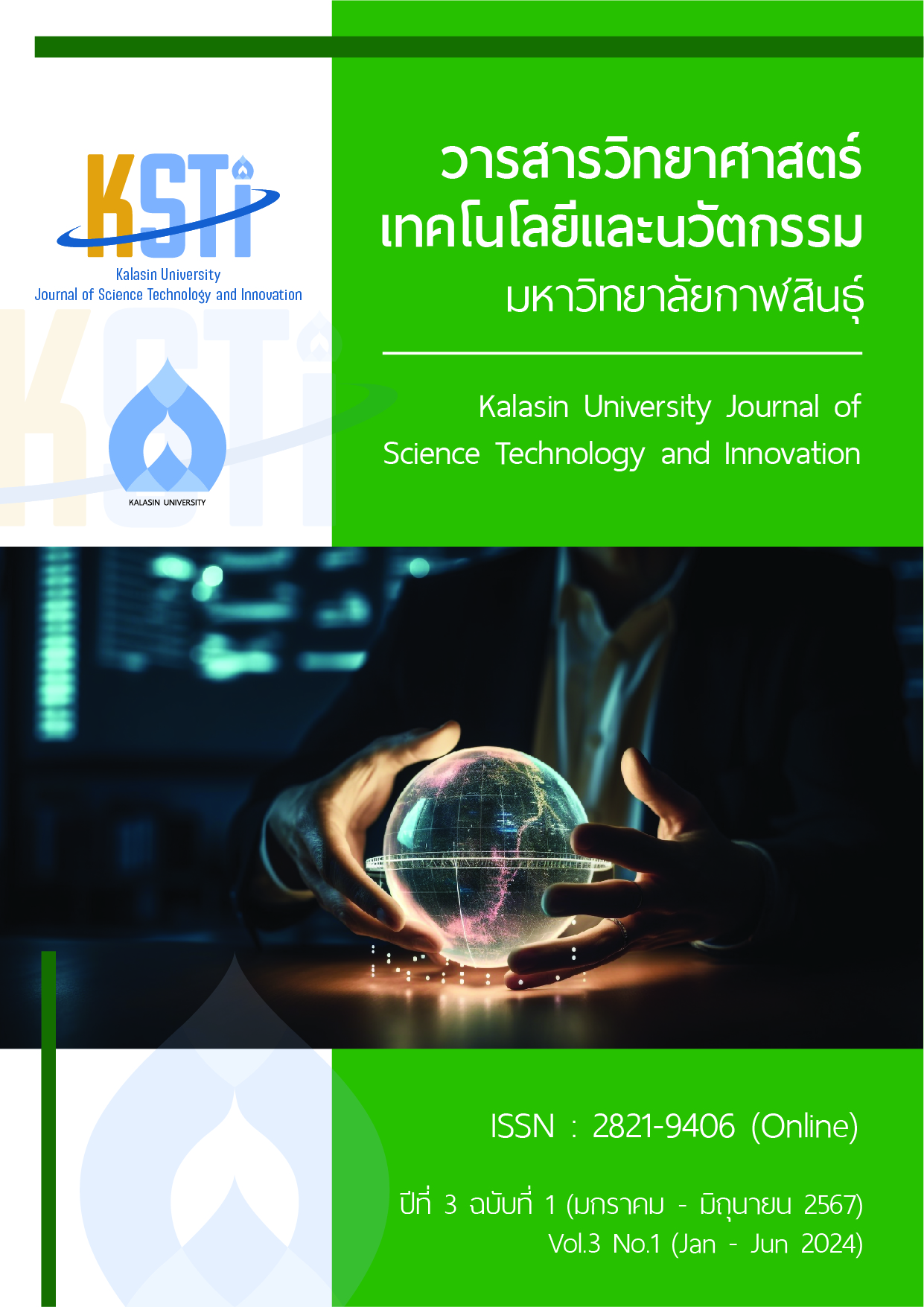ผลของสัดส่วนความต่างของแกลบและโฟมพอลิสไตรีนต่อความสามารถในการดูดความชื้นของแผ่นพื้นคอนกรีตน้ำหนักเบา
Main Article Content
บทคัดย่อ
งานวิจัยนี้มีวัตถุประสงค์เพื่อศึกษาคุณสมบัติแผ่นคอนกรีตน้ำหนักเบาด้วยการใช้วัสดุเหลือใช้จากภาคอุตสาหกรรมและทางการเกษตร ได้แก่ โฟมพอลิสไตรีน และแกลบ ผสมปูนซิเมนต์เพื่อผลิตเป็นคอนกรีตน้ำหนักเบา โดยหล่อขึ้นรูปเป็นแผ่นคอนกรีตสำหรับตากข้าวเปลือกและแผ่นทดสอบขนาด 30 x 30 x 5 เซนติเมตร และ 5 x 5 x 5 เซนติเมตร ซึ่งทำการทดสอบความหนาแน่น การทดสอบความสามารถดูดความชื้น การทดสอบความต้านทานแรงอัด และใช้การวิเคราะห์โดยวิธีทางสถิติ และนอกจากนั้นยังทำการวิเคราะห์ความคุ้มค่าทางเศรษฐศาสตร์ในการผลิตแผ่นคอนกรีต จากผลการทดลองพบว่าแผ่นคอนกรีตที่มีส่วนผสมปูนซีเมนต์:โฟมพอลิสไตรีน:แกลบในสัดส่วนที่ 3:1:1 3:2:0 และ 3:0:2 ทำให้แผ่นทดสอบมีน้ำหนักและความแข็งแรงที่เพิ่มขึ้น และสัดส่วนผสมของโฟมพอลิสไตรีนที่เพิ่มขึ้นทำให้น้ำหนักของแผ่นคอนกรีตมีน้ำหนักลดลง โดยความสามารถในการดูดความชื้นของแผ่นทดสอบเพิ่มขึ้นตามปริมาณของแกลบที่ผสมที่สัดส่วน 1:3:1 1:2:2 และ 1:1:3 ตามลำดับ ดังนั้นสัดส่วนที่เหมาะสมที่ทำให้แผ่นคอนกรีตมีน้ำหนักเบา คือสูตรที่ 2 มีสัดส่วน 1:2:2 (ปูนซีเมนต์:โฟมพอลิสไตรีน:แกลบ) ที่มีต้นทุนการผลิต 67.722 บาทต่อตาราเมตร
Downloads
Article Details

อนุญาตภายใต้เงื่อนไข Creative Commons Attribution-NonCommercial-NoDerivatives 4.0 International License.
เจ้าของลิขสิทธิ์ (สถาบันวิจัยและพัฒนา มหาวิทยาลัยกาฬสินธุ์) ผู้เขียน ตกลงว่าการทำสำเนาบทความหรือส่วนใดส่วนหนึ่งของบทความดังกล่าวในรูปแบบสิ่งพิมพ์หรืออิเล็กทรอนิกส์ตามที่ได้รับอนุญาต จะต้องระบุประกาศลิขสิทธิ์ตามที่กำหนดไว้ในวารสาร พร้อมทั้งอ้างอิงข้อมูลฉบับสมบูรณ์ของบทความที่ตีพิมพ์ในวารสารที่จัดทำโดย สถาบันวิจัยและพัฒนา มหาวิทยาลัยกาฬสินธุ์ อย่างครบถ้วนทุกครั้ง
เอกสารอ้างอิง
วันปิติ ธรรมศรี, นันทพร อ่อนปัดชา, อุษณีย์ ปีนอก, และมัณฑนา ศรีทองคำ. การนำวัสดุ เหลือใช้จากกากมะพร้าวมาใช้ในการผลิตคอนกรีตบล็อก. วารสารวิชาการมหาวิทยาลัยราชภัฏอุตรดิตถ์, 2022, 17.(1): 117-117.
ศุภชัย สินถาวร, นฤพัทธ์ สาทลาลัย, วิเชียร ศรีศักดา, และวัลลภ ดาราสม. ลานตากข้าวจากคอนกรีตผสมเถ้แกลบดำ. การประชุมวิชาการและเสนอผลงานวิจัยระดับชาติราชนครินทร์วิจัย ครั้งที่ 9. ฉะเชิงเทรา. มหาวิทยาลัยราชภัฎราชนครินทร์. เมษายน 2561.
Puljan, V., Luangwilai, T., Welamas, W., Meechowna, S., Leelayuth, S., and Moodleah S. Investigating the behaviour of heat transfer through building walls with different covering materials by using Method of Lines (MOL). NKRAFA JOURNAL OF SCIENCE AND TECHNOLOGY. 2021; 17(1): 1–10.
ธรพร บุศย์น้ำเพชร, นิพนธ์ตัน ไพบูลย์กุล. สมบัติของคอนกรีตมวลเบาผสมผงยางรถยนต์ที่มี การแทนที่ปูนซีเมนต์ด้วยเถ้าลอยจากโรงไฟฟ้าถ่านหิน. Veridian E-journal Science and Technology Silpakorn University, 2016, 3.(4): 62-75.
Padhi, R. S., Patra, R. K., Mukharjee, B. B., & Dey, T. Influence of incorporation of rice husk ash and coarse recycled concrete aggregates on properties of concrete. CONSTRUCTION BUILDING MATERIALS. 2018; 173:289–297.
P.D. Tennis, M.L. Leming, D.J. Akers, Pervious Concrete Pavements. No. PCA Serial No. 2828, Portland Cement Association, Skokie, IL, 2004.
มาตรฐานผลิตภัณฑ์อุตสาหกรรม.(2556). มาตรฐานผลิตภัณฑ์อุตสาหกรรมปูนซีเมนต์ไฮดรอลิก(มอก.2594-2556). สํานักงานมาตรฐานผลิตภัณฑ์อุตสาหกรรม. กรุงเทพมหานคร.
TENNIS P. D., BHATTY J. I. Characteristics of portland and blended cements: results of a survey of manufacturers. IEEE Cement Industry Technical Conference, 2006. Conference Record., Phoenix, AZ, USA, 2006: 19.
วันโชค เครือหงษ์, โสภณ สังข์แป้น, ประภิต สิทธิ์คณารักษ์, และ จีระศักดิ์ วิลัยรัตน์. สมบัติทางกลโครงสร้างจุลภาคและการนำความร้อนของคอนกรีตบล็อกผสมเถ้าลอย. วารสารวิจัยและพัฒนา มจธ., 2559; 39 (3): 407-425.
ASTM International. (2006). Standard test method for density, absorption, and voids in hardened concrete (ASTM C642-21). West Conshohocken: American Society for Testing and Materials.
ASTM International. (2020). Standard test method for compressive strength of hydraulic cement mortars (ASTM-C109M). West Conshohocken: American Society for Testing and Materials.
รมยธีรา จิตอารีย และมงคล นามลักษณ์. อิทธิพลของขนาดเม็ดโฟมโพลิสไตรีนต่อคุณสมบัติของคอนกรีตมวลเบา.วารสารวิจัยและนวัตกรรมการอาชีวศึกษา. 2019;3,(1): 11–18.
Raoul J., Frank R., Seni T., Ibrahima K. Properties of cement-rice husk mixture. Construction and building Materials., 2003; 17(4): 239-243.
Daneti S. B., Ganesh B. K., and Wee T.-H. Effect of polystyrene aggregate size on strength and moisture migration characteristics of lightweight concrete. Cement & Concrete Composites; 2006; 28: 520–527.
Allahverdi A., Azimi S.A., Alibabaie M.. Development of multi-strength grade green lightweight reactive powder concrete using expanded polystyrene beads. Construction Building Materials., 2018; 172: 457-467.
Songchai W., Kittiporn R., Pannee Y., Somchart S. Moisture Desorption of Paddy by Two Different Porous Media: Mathematical Models and Experimental Data. 2009; 32(3): 319–337.
Morgan C., Jean-Charles B., Laurent C., and Eric G. Use of raw rice husk as natural aggregate in a lightweight insulating concrete: An innovative application. Construction and Building Materials. 2014; 70: 428-438.
Witinantakit, K., Prachayawarakorn, S., Nathakaranakule, A., & Soponronnarit, S. Paddy drying using adsorption technique: Experiments and simulation. Drying Technology. 2006; 24 (5): 609-617.
Ganesh B. K. and Saradhi B.D. Behaviour of lightweight expanded polystyrene concrete containing silica fume. Cement and Concrete Research. 2003; 33: 755–62.


